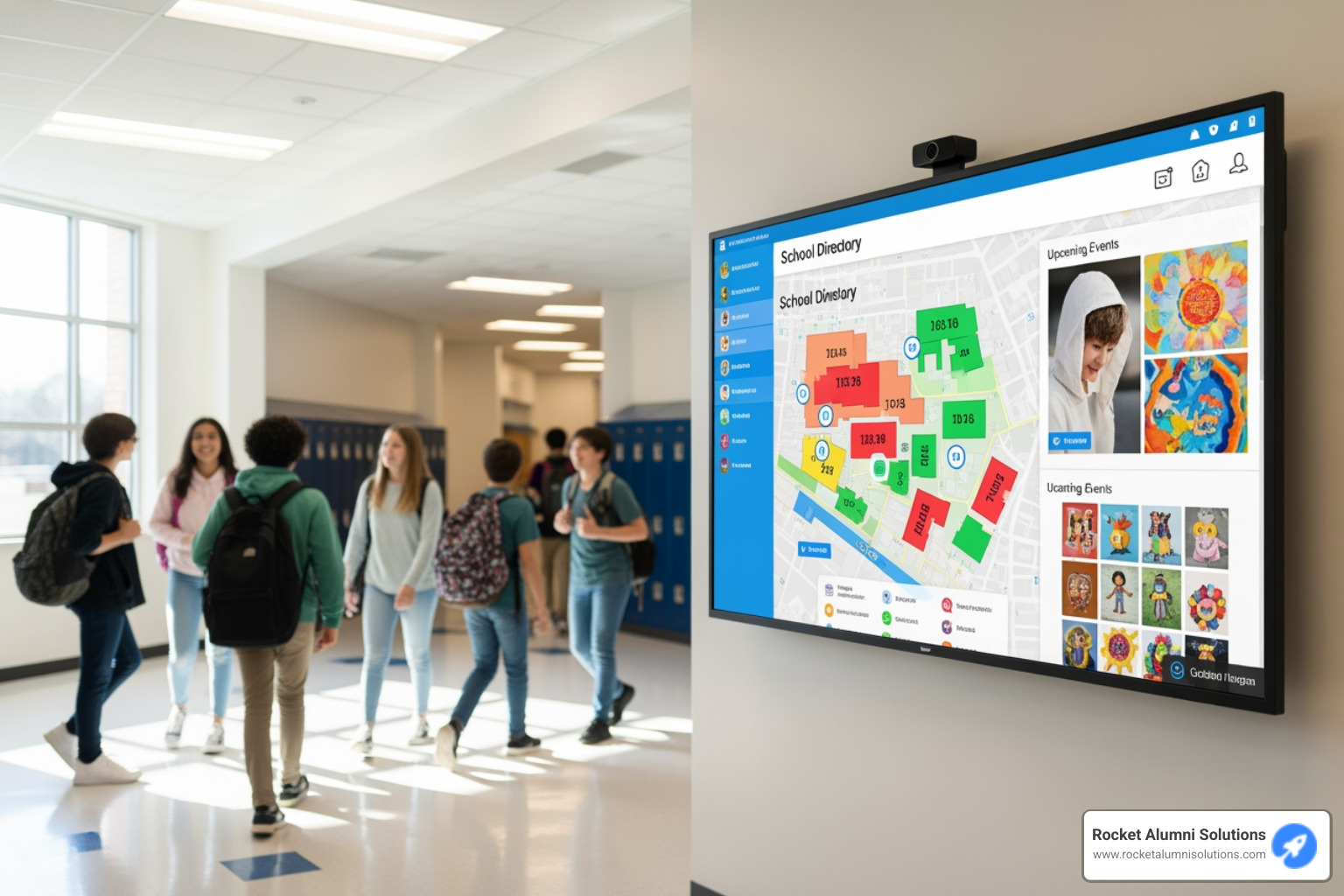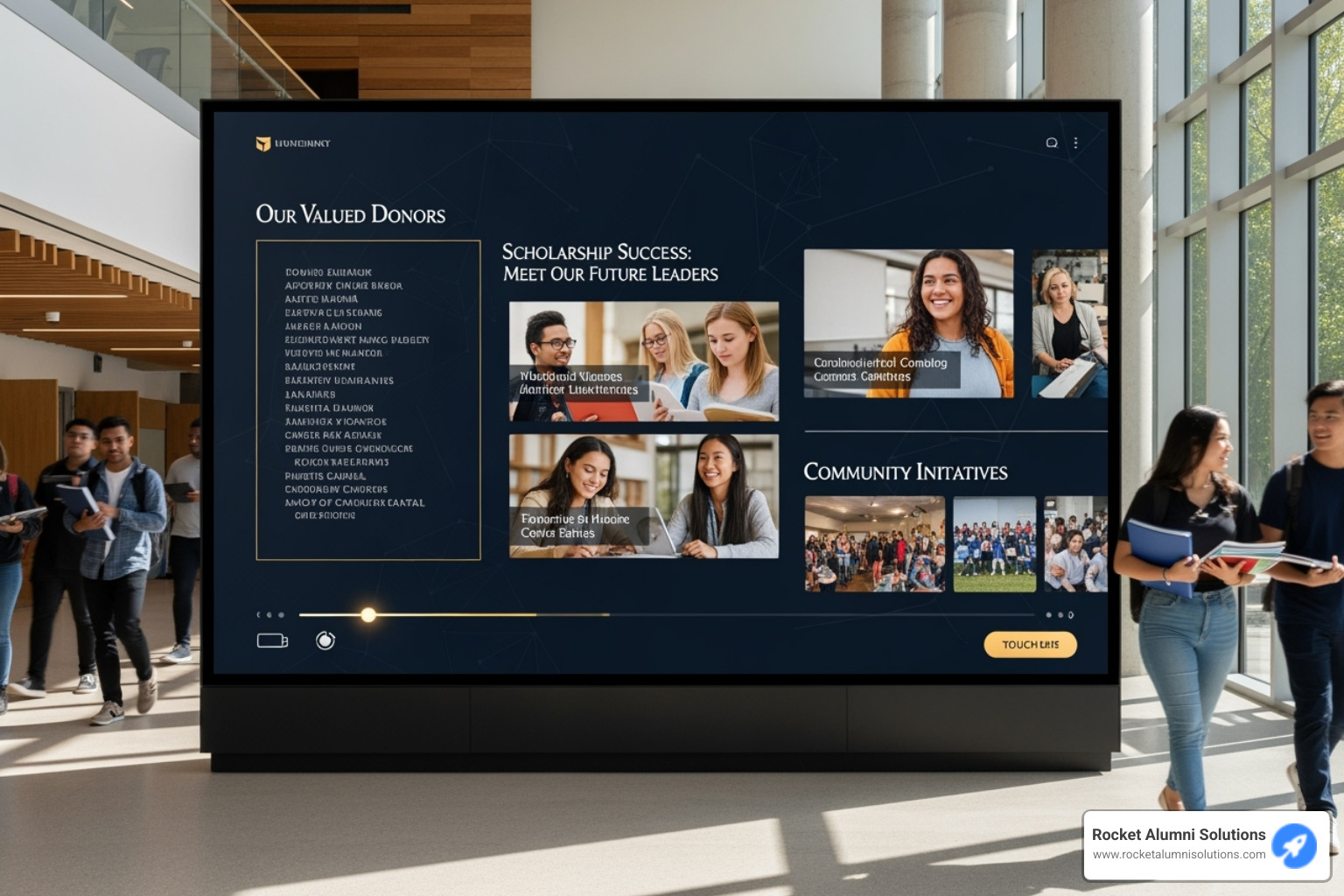Digital platform education is revolutionizing the way we learn and connect with our communities by integrating technology into educational environments. This approach not only enhances learning experiences but also fosters a deeper sense of belonging and community recognition. In schools, interactive touchscreens and digital tools can vividly showcase community achievements, creating a dynamic and engaging atmosphere.
- Bridging Technology & Education: By merging technology with teaching, digital platform education offers flexible and engaging learning environments that cater to diverse needs.
- Community Recognition: These platforms play a crucial role in enhancing community pride and recognition by interactively highlighting achievements.
- Sense of Belonging: Celebrating individual and collective contributions fosters a sense of belonging, strengthening community ties and creating a supportive environment.
Imagine a school where every student's success is celebrated through dynamic displays. These platforms instill a sense of pride and happiness that resonates with students, teachers, and the wider community. It's not just about the technology—it’s about building connections and nurturing a strong community foundation. Recognition and a sense of belonging bring lasting benefits, stimulating growth and positive change for everyone involved.

Digital platform education terms to remember:- alumni engagement solutions- digital legacy services- yearbook creation software
Understanding Digital Education Platforms
What is a Digital Platform in Education?
A digital platform in education is like a bridge connecting students, teachers, and educational content. These platforms use online tools to deliver, manage, and improve learning experiences. Imagine a classroom that exists both in the physical world and online, offering flexibility and accessibility to educational resources.
Digital platforms facilitate the delivery of educational content, making it easy for students to access materials anytime, anywhere. They also help in managing and improving learning processes by providing tools for assignments, quizzes, and interactive discussions. This integration of technology not only improves learning but also fosters a sense of community among learners and educators.
Types of Digital Education Platforms
Digital education platforms come in various forms, each catering to different learning needs and environments. Let's explore some common types:
Learning Destination Sites (LDS): These platforms offer a wide range of courses accessible to learners worldwide. They are perfect for individuals looking to upskill or explore new subjects. LDS platforms provide video-based learning, which allows students to learn at their own pace, making education more flexible and personalized.
Learning Management Systems (LMS): Used by educational institutions and organizations, LMS platforms are designed to build, deliver, and manage entire courses. They support group learning, where students can collaborate on projects and participate in discussions. LMS platforms also offer one-on-one learning opportunities, enabling personalized feedback and support from instructors.
In addition to LDS and LMS, there are learning ecosystems that combine various tools and resources to create a cohesive educational experience. These ecosystems support video-based learning, group learning, and one-on-one interactions, ensuring that every learning style is catered to.

Enhancing Interactions and Educational Content
Digital platforms do more than just deliver content; they improve interactions between students and educators. Through video calls, messaging, and interactive forums, these platforms create a virtual classroom environment where ideas are exchanged, and learning is collaborative.
Educational content on these platforms is often enriched with multimedia elements, such as videos, quizzes, and interactive modules. This not only makes learning more engaging but also helps in better retention of information.
In summary, digital learning platforms are changing education by making it more accessible, interactive, and custom to individual needs. They are not just tools but catalysts for creating a connected and supportive learning community.
Community Recognition and Belonging
Creating a sense of belonging is crucial in any educational environment. It fosters community recognition and helps individuals feel valued and connected. This sense of belonging is beneficial for children, adults, teammates, employees, faculty, and coaches alike. When people feel they belong, they are more engaged, motivated, and productive.
The secondary effects of fostering a sense of community include improved mental health, increased collaboration, and a supportive learning environment. Recognition and maintaining connections create happy nostalgia and strengthen bonds within the community. This is essential for personal growth and the overall success of educational initiatives.
Key Considerations for Adopting Digital Education Platforms
Budget-Friendly Choices
One of the most appealing aspects of digital education platforms is their cost-effectiveness. Many online platforms offer open-source Learning Destination Sites (LDSs) that allow learners to access a wealth of knowledge without spending a dime. These platforms, like Khan Academy, provide free courses and materials, making education accessible to everyone.
Additionally, many universities offer in-state tuition rates for their online courses, regardless of where the student resides. This can lead to significant savings, especially for out-of-state students. Plus, studying online eliminates the need for transportation, reducing costs associated with commuting or relocating.
Flexibility and Convenience
Digital education platforms offer unparalleled flexibility, allowing students to learn at their own pace and on their own schedule. This is particularly beneficial for those juggling a full-time job or other commitments. With online courses, there's no need to uproot your life to attend out-of-state schools; you can access top-notch education from the comfort of your home.
Remote learning through digital platforms means that you can attend classes from anywhere in the world. This not only opens up more educational opportunities but also allows for a diverse learning environment where students from different backgrounds can connect and collaborate.
Options for Every Learning Style
Digital education platforms cater to a wide array of learning styles, ensuring that every student can find a method that suits them best. For those who thrive in a social learning environment, group-based learning offers the camaraderie of in-person classes with the convenience of online access. These virtual classrooms allow students to engage in discussions and collaborate on projects in real-time.
On the other hand, some learners prefer a more personalized approach. One-on-one courses provide direct interaction with instructors, allowing for custom feedback and support. This method is ideal for students who want to dive deep into specific topics or need extra help.
For those with unpredictable schedules, video-based courses offer the ultimate flexibility. Students can watch lectures and complete assignments at their convenience, making it easier to balance education with other life responsibilities.
Community Recognition and Belonging
Creating a sense of belonging and community is crucial in digital education platforms. When students feel recognized and part of a community, it enhances their learning experience and motivation. This sense of belonging is beneficial not only for students but also for children, adults, teammates, employees, faculty, and coaches. It fosters a supportive environment where individuals feel valued and connected.
The positive effects of community recognition extend beyond the immediate learning environment. It can lead to improved mental health, increased engagement, and a stronger commitment to personal and collective goals. Additionally, maintaining connections and creating happy nostalgia through shared experiences can strengthen bonds and promote long-term success.
In conclusion, digital education platforms provide budget-friendly, flexible, and diverse learning options that cater to the unique needs and preferences of every student. By fostering a sense of belonging and community, these platforms create a supportive and inclusive learning environment that benefits everyone involved.
Steps to Implement Digital Education Platforms
Assessing Needs and Goals
Before diving into digital education, it's crucial to assess the needs and goals of your institution. Start by identifying educational objectives and understanding what students require to succeed. This means considering various factors, such as course content, learning styles, and technological capabilities.
Educational goals might include improving student engagement or expanding course offerings. Meanwhile, student needs could range from access to specific resources to flexible learning schedules. Align these goals with institutional requirements to ensure a cohesive strategy that supports both students and faculty.
In addition to these goals, fostering a sense of community and belonging is essential. When students and faculty feel recognized and connected, it enhances their educational experience. A strong community can lead to increased motivation, collaboration, and overall satisfaction. This sense of belonging is crucial not only for students but also for faculty, staff, and the broader educational community.
Selecting the Right Platform
Choosing the right digital platform can make or break your educational strategy. Look for platforms that are user-friendly and offer transparent pricing. A clear pricing structure helps you manage budgets effectively without unexpected costs down the line.
Consider the content formats the platform supports. Does it accommodate video lectures, interactive quizzes, or discussion forums? Versatility in content delivery can improve the learning experience and cater to different learning styles.
Also, prioritize platforms with robust support systems. Whether it’s technical assistance or customer service, having reliable support ensures that any issues are resolved quickly, minimizing disruptions to the learning process.
Moreover, the platform should facilitate community recognition and interaction. Features that allow for sharing achievements, creating group discussions, and maintaining connections can significantly enhance the sense of belonging among users. This not only improves engagement but also creates positive memories and nostalgia, strengthening the community bond.
Training and Support
Once a platform is selected, focus on training and support. Faculty training is essential to familiarize educators with the new tools and technologies. This can be done through workshops or online tutorials, ensuring that instructors feel confident in using the platform.
Ongoing technical support is vital for both faculty and students. Establish a helpdesk or support team that can address technical difficulties and provide solutions promptly. This ongoing assistance helps maintain a smooth and effective learning environment.
By carefully planning, prototyping, and developing custom online platforms, educational institutions can successfully implement digital education strategies that meet their goals and improve the learning experience for everyone involved. Creating a sense of belonging and community recognition further enhances these efforts, leading to a more connected and motivated educational environment.
Benefits of Digital Education Platforms
Enhancing Community Recognition
Community recognition is a powerful tool in educational settings. It fosters pride and motivation among students, teachers, and community members. Digital education platforms can improve this recognition by providing innovative tools like interactive touchscreens. These can serve as modern-day "Touchstones" for schools and communities, showcasing achievements and awards in a dynamic way.
Imagine walking into a school and seeing a digital display that celebrates student achievements, highlights faculty awards, and even honors community contributions. This not only boosts morale but also reinforces a culture of excellence and appreciation.
Such recognition platforms can be a game-changer in creating a sense of belonging. When individuals see their accomplishments highlighted, it validates their efforts and strengthens their connection to the community.
Creating a Sense of Belonging
Humans naturally crave a sense of belonging, and digital platforms can help nurture this essential need. For children, adults, teammates, employees, faculty, and coaches, feeling part of a community can significantly boost happiness and productivity.
Digital education platforms can facilitate this by fostering connections through features like group discussions, collaborative projects, and community forums. These interactions help build relationships, encourage teamwork, and create a supportive environment where everyone feels valued.
A strong sense of belonging can lead to positive outcomes, including increased engagement, improved well-being, and higher levels of achievement. It's a win-win for everyone involved.
Secondary Effects of Belonging
When a sense of belonging is established, it leads to secondary effects that further benefit the community. One such effect is the creation of happy nostalgia. As individuals participate in community events and achievements, they build memories that they cherish and reminisce about in the future.
Maintaining connections through digital platforms also ensures that these memories and relationships are sustained over time. This continuity creates a positive environment where learning and collaboration thrive.
Moreover, a sense of belonging can lead to increased retention rates in educational settings, as students and faculty are more likely to stay in an environment where they feel connected and appreciated. The ripple effects of belonging and recognition can thus contribute to the overall success and growth of both individuals and institutions.
Frequently Asked Questions about Digital Platform Education
What is the best online education platform?
Choosing the best online education platform depends on your specific needs and goals. Some platforms like Canvas are popular among colleges for their robust features and ease of use, with 41% of North American institutions using it. For those seeking free and open-source options, Moodle is a favorite due to its flexibility and customization capabilities. The "best" platform is one that aligns with your educational objectives, budget, and technological capacity.
How should you choose an online course platform?
When selecting an online course platform, consider these key factors:
Budget: Look for platforms that fit within your financial constraints. Some offer free courses with optional paid certifications.
User Experience: Choose a platform that is intuitive and user-friendly for both educators and learners.
Content Compatibility: Ensure the platform supports the types of content you plan to use, whether it's video, interactive modules, or text-based materials.
Community and Support: A platform with a strong community and reliable support can improve the learning experience. This is crucial for troubleshooting and continuous improvement.
Reputation: Look for platforms with positive reviews and endorsements from other educators or institutions.
What online learning platform do most colleges use?
In 2023, Canvas holds the largest market share among learning management systems (LMS) in North American higher education, with 41% of institutions utilizing it. This is due to its comprehensive features that facilitate communication, collaboration, and assessment. Blackboard follows with 17%, and Moodle and D2L Brightspace tie for third place with 16% each. Each of these platforms offers unique features that cater to different educational needs, making them popular choices among academic institutions.
The Importance of Community Recognition and Belonging
In the realm of digital platform education, fostering a sense of community and belonging is crucial. Community recognition and the feeling of belonging are fundamental human needs that significantly impact children, adults, teammates, employees, faculty, and coaches. When individuals feel recognized and part of a community, it leads to increased motivation, engagement, and overall well-being.
Creating a sense of belonging can have numerous positive secondary effects. For instance, students who feel connected to their educational community are more likely to participate actively and achieve better academic outcomes. Similarly, employees who experience a sense of belonging are more productive and committed to their organization's goals.
Recognition plays a vital role in maintaining connections and creating happy nostalgia. Celebrating achievements and milestones helps reinforce community bonds and encourages continued participation. By prioritizing community recognition and belonging, digital education platforms can enhance the learning experience and foster a supportive environment for all users.
Conclusion
Digital education platforms are revolutionizing the way we learn and connect, fostering a sense of belonging and community recognition. At Rocket Alumni Solutions, we are leading this transformation by offering innovative tools that enhance school and community engagement. Our digital yearbook services not only preserve cherished memories in an interactive format but also make them accessible on any device, honoring the past while engaging students, parents, and alumni in a dynamic way.
Creating a sense of belonging is crucial for everyone—children, adults, teammates, employees, faculty, and coaches alike. It brings about positive secondary effects, such as increased motivation, improved mental health, and stronger community bonds. Our social media integration capabilities enhance this by allowing schools to share achievements and highlights instantly, fostering pride and a sense of belonging among students and staff.
Our user-friendly media templates are designed to help schools easily create compelling content that showcases awards, achievements, and community stories. This ensures that recognition and appreciation are always front and center, maintaining strong connections within the community and creating happy nostalgia.
Incorporating these digital tools into educational environments not only modernizes the way we celebrate achievements but also strengthens community bonds. By fostering a sense of belonging and nostalgia, we contribute to a positive and supportive environment for everyone involved.
Explore how our solutions can improve your school's legacy by visiting our Interactive School Legacy Wall. Let's work together to celebrate your community's achievements and build lasting connections.

















































































































































































































































































































